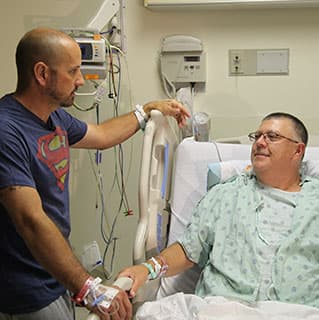What you should know about living kidney donation

About 95,000 people in the U.S. are waiting for a kidney transplant. Getting an organ from a living donor offers the best chance at a healthy life for those waiting for a new kidney. Approximately 6,000 people a year choose to donate one of their kidneys — sometimes to a family member and sometimes to a total stranger. At the University of Chicago Medicine Kidney and Pancreas Program, I work with our patients to help them understand living kidney donation.
Why would someone need to undergo an organ transplant to get a new kidney?
The kidney removes toxins, regulates calcium and phosphorus and produces hormones that are critical for good health. When a kidney starts to fail and is no longer able to rid the body of toxins, patients can become tired, lose their appetite, become nauseous and wind up quite ill. If their kidneys are functioning at 20 percent or less, or if they’re on dialysis, patients are able to be put on the transplant list. Unfortunately, many patients spend years on the waiting list because there are simply not enough organs available. For many kidney patients, their best chance of getting a transplant is to find a living donor — someone who is healthy and a good fit on a number of measures — who agrees to donate one of their two healthy kidneys.
Why are kidney donations from living donors ideal?
Kidneys, unlike a heart or lung, can be donated by a healthy, willing donor who is alive. Living donors offer the best chance of survival for transplant patients. When a kidney is transplanted from a living donor, the organ is immediately given to the recipient within hours, which minimizes the chance of complications during surgery and recovery. In cases of living donation, recipients who receive kidneys from living donors typically know where their organ is coming from, unlike people receive organs from a deceased donor.
What provisions are made for donors to ensure they can donate safely and freely?
Living donors undergo a series of evaluations to make sure they are physically and mentally healthy enough to undergo the operation, including blood tests, colonoscopies, heart screenings and other age-appropriate tests. Transplant programs also perform evaluations to make sure the donor can maintain a healthy lifestyle and will have an adequate support system after the surgery. Donors also have a designated advocacy team made up of nephrologists (kidney specialists), social workers and primary care providers who aren’t involved with the transplant case. Their job is to protect the donor’s best interests and make sure they aren’t being coerced into donating. While offering money for organs is illegal in the United States, donors can receive transportation, boarding and wage reimbursements to accommodate their hospital stay during the procedure.
How do I become a living kidney donor?
Organizations such as UNOS, Gift of Hope and the NKR assist potential donors interested in donating a kidney. For next steps to becoming a living donor at UChicago Medicine, take our living donor questionnaire.
Who are the ideal candidates for kidney donation?
Ideal donors can come from all walks of life. Sometimes complete strangers donate. The wait time to receive a kidney can be as long as five to eight years. In that time, a patient’s health can deteriorate, and they may not be well enough to undergo transplant surgery anymore. By knowing someone who they can receive a kidney directly from, the patient’s time spent on the wait time decreases dramatically. As long as the living donor is at least 18 years old and in overall good physical and psychological health, anyone can volunteer to be a living kidney donor. Read our tips on how to find a living donor.
What’s the kidney procurement surgery like for a living donor?
UChicago Medicine is one of only a handful of centers in the United States to offer nearly scarless removal of a donor’s kidney. For this procedure, a single small incision is made in the belly button through which instruments are placed and the kidney removed. Most patients wake up with a small band aid over the belly button, the scar hidden inside it. This nearly scarless nephrectomy is as safe as the traditional laparoscopic approach that involves making multiple small incisions and a longer extraction incision to remove the kidney. These minimally-invasive laparoscopic surgeries offer significantly reduced recovery times, and donors are often released from the hospital the next day.
If I want to donate my kidney, but I’m not a match for a family member who needs a transplant, can I still help someone?
Donors who are not good matches for their potential recipient are eligible to enroll in paired kidney exchange (PKE) programs. These programs have large registries of patients to allow for matching between donors and recipients. Organizations like the National Kidney Registry (NKR) and the Alliance for Paired Kidney Donation work to ensure patients can receive the best match for their kidney transplants with the best outcomes for patients and donors. If a living donor’s kidney is not a good match for their chosen recipient, donors can give their kidney to another waitlist patient in exchange for another donated kidney that better matches the patient they are advocating for. This “swap” program can also offer support and financial protection for living donors after they donate.
What happens to living donors after they donate their kidney?
After their operation, kidney donors have follow-up appointments immediately after surgery, at six months and then one and two years after donation to ensure their health is in stable condition after donating. Donors typically recover faster than recipients and report that they are glad they donated their organ to someone in need.

John LaMattina, MD
Dr. LaMattina is a skilled transplant surgeon with a particular interest in both living donor liver and living donor kidney transplantation.
See Dr. LaMattina's physician profile
Living Kidney Donors
Living donors can donate a kidney to another person in need. Learn if receiving a living-donor organ is an option for you.
Learn about living organ donation